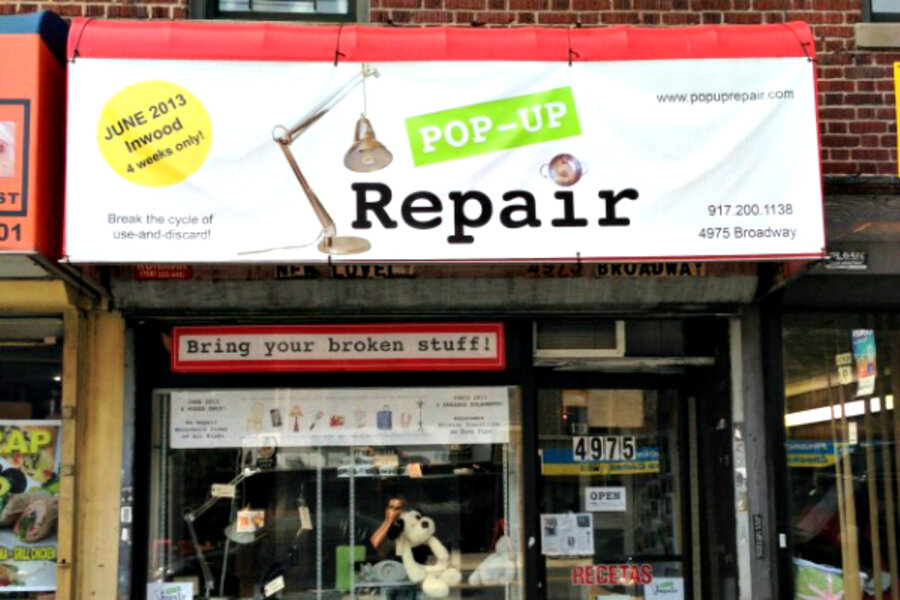Reduce, reuse, recycle – and repair: New York's Pop-Up Repair shop
Loading...
Throwing away broken stuff has never been an easier choice. For some items, prices have never been lower; for others, instant obsolescence means you always have an excuse to upgrade, as if you needed an excuse. Can the possibility of repair begin to change consumer habits?
New York City’s Pop-Up Repair shop was a one-month experiment this June aimed at breaking the cycle of use-and-discard goods. It was the first step of a larger exploration of the issue, led by Sandra Goldmark, a set and costume designer and theater professor at Barnard College.
Sandra and her husband, Michael Banta, a theater production manager at Barnard, launched the shop using funds from an IndieGoGo campaign, which raised more than $9,000.
Besides suffering from the frustration of a broken toaster oven and a broken printer about a year and a half ago, the couple found some inspiration in theater for the shop.
“For every show, we make and throw away stuff to make a fantasy world, again and again, and it is just a constant reminder that there’s a whole world of real stuff going through the same cycle,” Sandra says.
Her father, by the way, is lifelong environmentalist Peter Goldmark, former president of the Rockefeller Foundation and former executive director of the Environmental Defense Fund.
Theater also provided an ideal skill set for repair.
”Everything we’ve been able to do here, we learned how to do because of theater,” Michael adds. Many of the “repair wizards” who staffed the shop also came from the theater world.
Customer volume far exceeded Sandra and Michael’s expectations. More than 190 customers brought in more than 360 items to repair. One customer brought in 14 items. The first 25 customers were offered pay-as-you-will prices, to get a sense of what people were willing to pay before settling on some set prices for common goods.
Getting a sense of what people would pay was part of the experiment. Chairs, lamps, fans, other small electronics, including iPhones, and also stuffed toys were popular items. Most customers came from the Inwood neighborhood of New York City where the shop was located in a tiny rented former pharmacy on Broadway.
As part of the experience, customers answered a set of questions, including, “Are you bringing this in to get fixed because it has sentimental value, avoiding the higher cost of a replacement, or to help the environment?” as well as, “On a scale of one to 10, one being not at all and 10 being very strong, how much of an environmentalist would you consider yourself to be?”
Barnard College provided a research grant to support data collection, analysis, and a “theatrical response” to be crafted based on the shop experience.
As it turned out, Sandra says, “a lot of people coming into the shop rated themselves high as an environmentalist but they rarely said that they’re coming in for that. They just want their things fixed. I think, in a weird way, they’re selling themselves short.”
At the Natural Resources Defense Council, one of the largest environmental action groups in the United States, known for working with the recording academy to reduce the environmental footprint of the Grammy Awards, senior resource specialist Darby Hoover weighed in on incentives against repair and on the possibility of changing consumer habits.
“One particular thing that happened in just the past 20 years or so was that the pace at which we generate new technology has accelerated so much that by the time something breaks, it’s already outdated,” Darby says. “There’s no incentive to repair. There’s always something newer and better.”
The situation is not entirely hopeless.
”We’ve also created much better ways of connecting so there are more options to mix and match something that’s broken with someone who knows how to repair it or find a video of someone showing how to repair it,” Darby says. “I think what we really need to do is match the information with the mentality. We need to remind ourselves that there is value in repair, and there is value in trying to keep something out of the landfill.”
Darby referenced a few for-profit firms in the San Francisco Bay Area, where she is located, that are designed to keep stuff out of the landfill, including Urban Ore in Berkeley, Calif., tfounded in 1980, and Recology, an employee-owned firm in San Francisco that runs 20 programs designed to increase recycling and reuse.
Between ordering parts, rent, and utilities, and compensation for repair wizards, the Pop-Up Repair shop still turned out to be a losing venture, financially.
”We don’t think right now there’s any way to charge enough for this model to really achieve financial independence,” Sandra says.
She remains optimistic.
“I think the attitudes around stuff in our country may start to follow along similar lines as the food movement,” Sandra says. “The first farmers market in New York opened in the mid 1970s, so this food movement has been building for a long time and is still frankly small compared to the mainstream. When it comes to stuff, at least in the Inwood community, I feel like people are ready for a similar change in habits, if we just provide them a way.”





